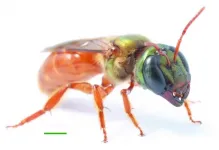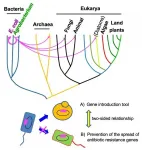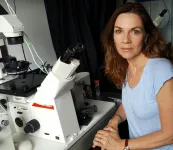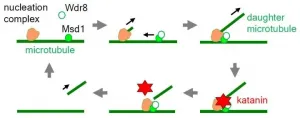(Press-News.org) People--who get lost easily in the extraordinary darkness of a tropical forest--have much to learn from a bee that can find its way home in conditions 10 times dimmer than starlight. Researchers at the Smithsonian Tropical Research Institute's (STRI) research station on Barro Colorado Island in Panama and the University of Lund in Sweden reveal that sweat bees (Megalopta genalis), find their way home based on patterns in the canopy overhead using dorsal vision. This first report of dorsal navigation in a flying insect, published in Current Biology, may be of special interest to makers of drones and other night-flying vehicles.
"One of the pioneers of studies on homing behaviors in bees was Charles H. Turner, an African-American scientist from the University of Chicago," said William Wcislo, staff scientist at STRI, "He wrote in the Biological Bulletin in 1908: 'burrowing-bees use memory in finding the way home, and that they examine carefully the neighborhood of the nest, for the purpose of forming memory pictures of the topographical environment of the burrow.' But what we didn't understand until now, was that the cues that the bees are memorizing are overhead, as well as in front of their faces."
No one knows why the sweat bees on Barro Colorado Island prowl from flower to flower like crepuscular cats, gathering pollen only for about 70 minutes before sunrise and after sunset. Especially because it is 100 times darker on the tropical forest floor where the bees live inside dead twigs and vines, than above the forest canopy.
Since the late 1990's Eric Warrant and his team from the Vision Group at the University of Lund in Sweden has collaborated with Wcislo to learn more about Megalopta's optical superpowers. Their work showed that Megalopta's special compound eyes are 30 times more sensitive to light and concentrate photons of light in a way day-flying honeybee eyes cannot. By identifying pollen from the bees' bodies and their nests, they discovered that the bees gather pollen from more than 60 plant species: tall canopy trees like Hura crepitans, and Pseudobombax septenatum, to understory shrubs in the coffee family like Faramea occidentalis.
"For a human observer, the most obvious visual cues in the forest at night are gaps in the canopy when we look straight up because the sky is much brighter than the forest below," Warrant said, "We see a quite complex pattern of criss-crossing branches, but the bees'-eye-view is much less complex. They see broad blobs of light that vary in shape and position. We knew that ants could use canopy patterns to navigate as they walk through the forest, and we wondered if maybe bees were doing the same thing."
Honeybees can't do this, but to find out if Megalopta bees had yet another superpower, Sandra Chaib, a student at the University of Lund, moved to Barro Colorado Island to do the experiments.
To test this idea, Sandra first set up a special bee motel. Imagine the entrances to five rooms: each entrance is an identical, circular grey disc. The door is a tiny round opening at the center of the disc--the end of a stick nest.
In the first experiment, she asked if the bees could find their way home using a single landmark. She placed a black bar above the entrance to one of the nests. After the bees left to look for pollen, she changed the order of the nests, but the real nest was still marked by the black bar above the entrance. When the bees returned, they chose the right nest.
Next, she made it a bit more complicated by building a sort of awning--like the roof of a carport--above each nest entrance. Over the four empty nests she placed an awning with a pattern of black and white bars, and over the occupied nest, a different pattern. Again, when the bees went out, she changed the position of the nest, and again, they found the right nest when they came back. But she still had not ruled out the possibility that the bees were using another clue, like smell, to find their own nest. So she left the nest in the same place, but put the bee's learned pattern over an empty nest...and the bees chose the empty nest, showing that they were using the pattern as a guide, not smell or some other signal from the nest.
Her final experiment was the most elegant: this time two nests shared a common awning, a design of dark circles on a light background made to represent the patterns of light and dark in real forest canopies. The entrance to an empty nest was located under one end of the awning, and the entrance to the occupied nest under the opposite end. This time, when the bees left, Sandra flipped the awning around so that the pattern was reversed. The bees chose the wrong nest more than 80 percent of the time, showing once and for all that they were navigating based on the pattern above.
Understanding how Megalopta navigates may be of interest for military applications. Now, most drones use GPS to navigate, but GPS and satellites can be jammed or destroyed.
"Animals use a variety of different cues to navigate. Vision is obviously a very important one, but many animals have a magnetic sense and can measure properties of the Earth's magnetic field to work out where they are on the surface of the Earth and the direction they want to travel. We have already learned about insects and other animals that are able to use the stars for navigation; pigeons are able to use odors for navigation...there are lots of different cues. The canopy is one cue that a drone can use to navigate, but a really robust navigational system will be one that will use a number of different cues, like animals have, to use all of these systems at once to navigate."
STRI Facilities are still closed due to COVID-19 restrictions but researchers are itching to get back out "So far we only know how the bees identify which room in the bee motel is theirs when they come home," Wcislo said. "We still have no idea how they navigate through the forest after they leave their nests."
INFORMATION:
A version of this study was made available online in March 2021 ahead of final publication in the print issue on August 23, 2021.
The Smithsonian Tropical Research Institute, headquartered in Panama City, Panama, is a unit of the Smithsonian Institution. The institute furthers the understanding of tropical biodiversity and its importance to human welfare, trains students to conduct research in the tropics and promotes conservation by increasing public awareness of the beauty and importance of tropical ecosystems.
Bacteria do not sexually reproduce, but that does not stop them from exchanging genetic information as it evolves and adapts. During conjugal transfer, a bacterium can connect to another bacterium to pass along DNA and proteins. Escherichia coli bacteria, commonly called E. coli, can transfer at least one of these gene-containing plasmids to organisms across taxonomic kingdoms, including to fungi and protists. Now, researchers from Hiroshima University have a better understanding of this genetic hat trick, which has potential applications as a tool to promote desired characteristics or suppress harmful ones across genetic hosts.
They published their results on ...
Young people with poor mental health took a turn for the better during the pandemic but those with good mental health saw a considerable decline, new research reveals.
The first nationally representative evidence regarding the diverse impact of the COVID-19 pandemic on adolescent mental health in the UK was led by researchers at Lancaster University working with the University of British Columbia in Canada.
Adolescents (aged 10 to 16) with better than average mental health before the pandemic experienced an increase in their emotional and conduct problems, hyperactivity, and problems interacting with their peers and friends, but a decrease in their prosocial ...
Scientists have identified key molecular events in the developing human embryo between days 7 and 14 - one of the most mysterious, yet critical, stages of our development.
The second week of gestation represents a critical stage of embryo development, or embryogenesis. Failure of development during this time is one of the major causes of early pregnancy loss. Understanding more about it will help scientists to understand how it can go wrong, and take steps towards being able to fix problems.
The pre-implantation period, before the developing embryo implants into the mother's womb, has been studied extensively in human embryos ...
Ikoma, Japan - The katana, a Japanese sword, may be thought of solely as a weapon used by the samurai. But researchers from Japan have discovered that not only do plants wield their own katanas within their cells, they recruit them to specific locations within those cells to do their work.
In a study published in Nature Communications, researchers from Nara Institute of Science and Technology have revealed that the enzyme katanin, which is named after the katana, is used by an anchoring complex to cut microtubules at specific locations of the framework within individual plant cells.
Katanin ...
NEW YORK (June 17, 2021)--New York City neighborhoods that had higher levels of socioeconomic disadvantage experienced more COVID-19 infections and deaths, according to Mount Sinai scientists who created a neighborhood-level COVID-19 inequity index.
The index measured factors that fueled inequities in the residents' lives, such as employment and commuting patterns, population density of their neighborhood, food access, socioeconomic status, and access to health care. This allowed the scientists to compare between neighborhoods the contributions of these social factors in facilitating disease transmission during the first wave of the pandemic in a study published in Nature Communications in June.
"Much of the early rhetoric around COVID-19 ...
As almost all our private information is digitalized, it is increasingly important that we find ways to protect our data and ourselves from being hacked.
Quantum Cryptography is the researchers' answer to this problem, and more specifically a certain kind of qubit - consisting of single photons: particles of light.
Single photons or qubits of light, as they are also called, are extremely difficult to hack.
However, in order for these qubits of light to be stable and work properly they need to be stored at temperatures close to absolute zero - that is minus ...
AI is used in an array of extremely useful applications, such as predicting a machine's lifetime through its vibrations, monitoring the cardiac activity of patients and incorporating facial recognition capabilities into video surveillance systems. The downside is that AI-based technology generally requires a lot of power and, in most cases, must be permanently connected to the cloud, raising issues related to data protection, IT security and energy use.
CSEM engineers may have found a way to get around those issues, thanks to a new system-on-chip they have developed. It runs on a tiny ...
Bottom Line: Genetic mutations indicative of DNA damage were associated with high red meat consumption and increased cancer-related mortality in patients with colorectal cancer.
Journal in Which the Study was Published: Cancer Discovery, a journal of the American Association for Cancer Research
Author: Marios Giannakis, MD, PhD, an assistant professor of medicine at Harvard Medical School and a physician at Dana-Farber Cancer Institute
Background: "We have known for some time that consumption of processed meat and red meat is a risk factor for colorectal cancer," ...
The unique mechanical and optical properties found in the exoskeleton of a humble Asian beetle has the potential to offer a fascinating new insight into how to develop new, effective bio-inspired technologies.
Pioneering new research by a team of international scientists, including Professor Pete Vukusic from the University of Exeter, has revealed a distinctive, and previously unknown property within the carapace of the flower beetle - a member of the scarab beetle family.
The study showed that the beetle has small micropillars within the carapace - or the upper section of the exoskeleton - that give the insect both strength and flexibility to withstand damage very effectively.
Crucially, these micropillars are incorporated into highly regular layering in the exoskeleton ...
Sophia Antipolis - 17 June 2021: People living with obesity who attended a non-judgemental and personalised lifestyle modification programme improved their cardiovascular and mental health during just 10 weeks, according to a study presented today at EuroHeartCare - ACNAP Congress 2021, an online scientific congress of the European Society of Cardiology (ESC).1 Participants lost weight and achieved benefits in anxiety and depression and physical measurements including blood pressure.
"We focus on changing behaviours and improving people's relationship with food," said study ...



